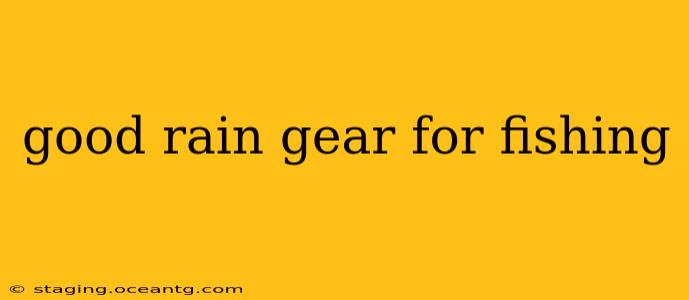Fishing is a fantastic pastime, but Mother Nature doesn't always cooperate. A sudden downpour can quickly turn a relaxing day on the water into a miserable experience. That's why investing in good rain gear specifically designed for fishing is crucial. This isn't just about staying dry; it's about staying comfortable, focused, and ultimately, catching more fish. This guide will help you navigate the world of fishing rain gear and find the perfect suit for your needs.
What Makes Fishing Rain Gear Different?
While a standard raincoat might seem sufficient, fishing rain gear offers several key advantages:
-
Breathability: Fishing often involves physical activity. Regular rain gear can trap sweat, leaving you clammy and uncomfortable. Fishing rain gear prioritizes breathability, allowing moisture vapor to escape while keeping water out. Look for gear made from breathable fabrics like Gore-Tex or similar waterproof-breathable membranes.
-
Durability: Fishing gear faces harsh conditions, from sharp hooks to rough terrain. Fishing rain suits are designed to withstand the wear and tear of a day on the water, featuring reinforced stitching and durable materials.
-
Functionality: Fishing rain gear often incorporates features tailored to anglers' needs, such as roomy pockets for tackle boxes, adjustable hoods for optimal visibility, and articulated designs for ease of movement.
-
Visibility: Safety is paramount when fishing. Many fishing rain suits incorporate high-visibility elements, like reflective strips, to enhance visibility in low-light conditions.
H2: What are the best materials for fishing rain gear?
The best materials for fishing rain gear prioritize both waterproofing and breathability. Here are some top contenders:
-
Gore-Tex: A premium option known for its exceptional waterproofness and breathability. Gore-Tex gear is generally more expensive but offers superior performance.
-
Nylon with a PU coating: A more budget-friendly alternative that provides good waterproofness. The breathability is typically less than Gore-Tex, but still sufficient for many anglers.
-
Polyester with a waterproof membrane: Similar to nylon, polyester offers a balance between cost and performance. Look for gear with a reputable waterproof membrane for better results.
H2: What features should I look for in fishing rain gear?
Beyond the material, consider these essential features:
-
Waterproof zippers: Zippers are often a weak point in rain gear. Look for waterproof zippers to ensure complete protection from the elements.
-
Adjustable hood: A hood that adjusts snugly to your head will keep rain out and provide better visibility.
-
Multiple pockets: Plenty of pockets allow you to keep your essentials close at hand, like your phone, wallet, and tackle.
-
Articulated elbows and knees: This allows for a full range of motion while casting and reeling.
-
Pit zips: These underarm zippers allow for ventilation and help regulate your body temperature.
H2: How much should I spend on fishing rain gear?
The price of fishing rain gear varies greatly depending on the brand, materials, and features. You can find budget-friendly options for under $100, while high-end suits can cost upwards of $300. Consider your budget and fishing frequency when making your decision. A higher-quality suit will likely last longer and offer better protection.
H2: How do I choose the right size for my fishing rain gear?
Proper sizing is crucial for comfort and functionality. Consult the manufacturer's size chart carefully. It's generally better to choose a slightly larger size to allow for layering underneath and freedom of movement. Consider trying on the gear if possible before purchasing.
H2: How do I care for my fishing rain gear?
Proper care extends the life of your rain gear. Always follow the manufacturer's cleaning instructions. Generally, you should avoid harsh detergents and machine drying. Air drying is recommended to preserve the waterproof and breathable properties of the fabric.
Conclusion
Investing in quality fishing rain gear is a wise decision for any angler who wants to stay comfortable and productive regardless of the weather. By considering the factors outlined above—material, features, and budget—you can find the perfect suit to keep you dry, comfortable, and focused on what truly matters: the catch.
